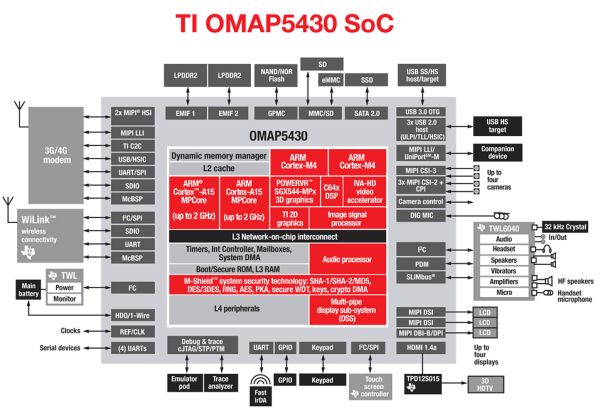TI Reveals OMAP 5: The First ARM Cortex A15 SoC
by Anand Lal Shimpi on February 7, 2011 8:59 PM EST- Posted in
- Smartphones
- OMAP
- Arm
- TI
- Cortex A15
- Mobile
- SoCs
TI sure does have impeccable timing. Not 12 hours after we published our LG Optimus 2X and NVIDIA Tegra 2 review, complete with a discussion of the 2011 SoC space, did TI announce its OMAP 5 SoC.
OMAP 5 will go into production in the second half of 2011 and ship in phones during the second half of 2012. It’s a 28nm SoC with significant architectural upgrades compared to the OMAP 4.
While the OMAP 4 integrates a pair of ARM Cortex A9 cores, OMAP 5 features two ARM Cortex A15 cores. TI already announced that it was ARM’s first licensee of the Cortex A15, so the OMAP 5 announcement is not too surprising.
The ARM Cortex A15 cores can run at speeds of up to 2GHz, although specific frequencies will depend on the OEM implementation. At 2GHz TI claims the pair of Cortex A15s should be 3x the speed of the 1GHz Cortex A9s in the OMAP 4330. At the same clock speed, TI is boasting a 50% performance advantage from the A15 over the A9.
With the OMAP 3 TI had a 256KB L2 used by its single Cortex A8. The OMAP 4 quadrupled L2 cache size to 1MB and shared it among both of its Cortex A9s. TI’s OMAP 5 doubles L2 cache size to 2MB, operating at the CPU clock speed, and it’s once again shared by the SoC’s two CPU cores (in this case Cortex A15s). The OMAP 5 retains the same dual-channel LPDDR2 memory interface from the OMAP 4.
Architecturally we still don’t know much about what makes up a Cortex A15, although I suspect we’ll get more of that in the coming months. Update: It looks like ARM has released some info on the A15. It appears to be a wider, deeper, even more OoO architecture. More on this later.
In our Tegra 2 review I mentioned that the transition from ARM11, to Cortex A8 and now to Cortex A9 left us with a generational performance improvement each step of the way. The move to A15 will be no different. ARM’s Cortex A8 went mainstream in the performance segment in 2010, Cortex A9 will do the same in 2011 and with any luck we’ll see A15 before the end of 2012. It’s this sort of yearly cadence that ARM and its partners must keep up in order to really catch up and surpass what Intel has been promising with Atom. Atom came out in 2008 and it won’t be until late 2012 that its architecture is truly refreshed. For a company that survived the mistakes of NetBurst, Intel doesn’t seem to have learned much of a lesson there.
In addition to its dual Cortex A15 CPUs, the OMAP 5 will feature two ARM Cortex M4 cores as well. The M4 isn’t very useful as a general purpose microprocessor, it only supports the ARM Thumb/Thumb-2 instruction sets (not the full 32-bit ARMv7-A ISA). The M4 does have a suite of signal processing extensions that can be used to accelerate audio/video encode and decode. One application of the M4s will be still picture enhancement. A goal for the next-generation of SoCs is to begin to bridge the gap between smartphone camera quality and high-end point-and-shoot and DSLR cameras. Obviously we’ll always be bound by the poor optics possible on smartphones, however there’s still a lot that can be done in hardware to improve the quality of what’s captured.
The OMAP 5 supports up to four cameras. One demo I saw Intel put together a while ago was of a smartphone with two equal resolution/quality cameras on its back. The only difference between the two was the focal length of the lens. Whenever you took a photo with the demo camera you’d actually capture the scene at two (vastly) different focal lengths. The SoC (in this case an Atom) would use the captured data to produce one image where the entire scene was in focus, with improved sharpness/detail over a single camera solution. It’s possible that OMAP 5 based smartphones may feature similar technologies and use its Cortex M4s to merge/interpolate data from the camera sensors.
As ARM’s CPUs grow in power consumption, the amount of fixed function or specialized silicon set aside to offload various tasks will increase. The Cortex A15s should be used only for those applications that absolutely need them, anything else should be offloaded.
The OMAP 5 SoC integrates Imagination Technologies’ PowerVR SGX 544 GPU, although it’s unclear how many cores will be present in TI’s implementation. Each SGX 544 core has four USSE2 pipes compared to four USSE pipes in the SGX 540, and two USSE pipes in the SGX 530. Each USSE2 pipe offers an increase in compute power compared to the old USSE pipes, however I don’t have details on specific differences in internal organization.
TI announced two versions of the OMAP 5: the 5430 and 5432. The OMAP 5430 features a 14 x 14mm PoP with LPDDR2 memory support, while the 5432 is a larger 17 x 17mm BGA package with DDR3/DDR3L support. The 5430 will likely be used in smartphones while the 5432’s larger size would be better suited for tablets.
On paper alone the OMAP 5 looks to be very powerful, but it needs to be. Also shipping in 2012 will be Qualcomm’s MSM8960 and we may see Project Denver as well. The application processor race hasn’t even begun to heat up, but it’s starting to get interesting.












39 Comments
View All Comments
metafor - Wednesday, February 9, 2011 - link
I've seen those numbers too and the reason the A15 wins out in those cases is that its idle leakage numbers are about 4x lower than the 65nm A8.Based on the numbers for 28LPG, unless they have seriously drastic micro-architected power gating, this is not true.
It may be too soon to count A15 out for mobile, I agree. But judging by the micro-architecture, it's going to push it. At least at 28LPG.
NCM - Tuesday, February 8, 2011 - link
System power consumption seems like the big unknown. The 28nm process should help, but it would be interesting to know what sort of of processor throttling can be applied to non-critical tasks. And it won't help to be able to render a web page in an eye-blink if you're still waiting for its content to download over the cellular network.I'm as interested in potential 2 x 2GHz speed as the next user, but not if it sucks my battery dry.
bah12 - Tuesday, February 8, 2011 - link
Please don't do that...Equate ZOMG Ghz with power. It is exactly that mentality that allowed Intel to sell the scourge that was NetBurst. Brazos will (in all likelyhood) not be "slower" as you claim there is far more to speed than Ghz.Wilco1 - Tuesday, February 8, 2011 - link
Brazos would need at least 25% better IPC for a 1.6GHz Brazos to beat a 2GHz A15. Since Brazos is 2-way OoO, and A15 is 3-way OoO, I doubt that. Brazos will likely have an advantage on DP FP but I expect the A15 will win on integer code.While the A15 has twice as many pipeline stages as the A9, we're not talking about anything approaching NetBurst. Brazos actually has a similar pipeline (also 15 stages). When comparing similar micro architectures clockspeed matters a lot.
iwod - Monday, February 7, 2011 - link
We are still stuck with LPDDR2, which is slow. One would expect an upgraded GPU plus CPU requires a much higher amount of bandwidth.PowerVR had enough of their PowerVR 6 series PR, and we are still not seeing it.
Hopefully Qualcomm and Nvidia would bring in some healthy competition.
MrSpadge - Tuesday, February 8, 2011 - link
You can bet they evaluated faster options, but probably choose LPDDR2 due to cost (including package size & pin count) and power consumption reasons. The doubled L2 cache was probably more power efficient than going for faster RAM.MrS
DanNeely - Tuesday, February 8, 2011 - link
Does LPDDR3 even exist as a standard? A bit of googling appears to only have false hits (rambus posturing, ddr3 gpus, low power dimms). Standard ram is too power intensive for mobile devices (in addition to having more pins to connect); so until LPDDR3 is available LPDDR2 is the best that can be used.AnnonymousCoward - Monday, February 7, 2011 - link
"there’s still a lot that can be done in hardware to improve the quality of what’s captured."Yeah, for starters, stop the stupid Megapixel race and start optimizing quality, by valuing pixel size versus count, and considering that above 4MP is probably pointless on digital displays since 24" is only 1.9MP.
beginner99 - Tuesday, February 8, 2011 - link
yeah agreed and higher MP can actually lead to worse quality depending on how it is implemented. And it sure is bad on smartphones. Noise...strikeback03 - Tuesday, February 8, 2011 - link
Well when you have no optical zoom the best you can do is crop out the part of the image you are actually interested in, which is where more MP helps. As mentioned though settling on something smaller and with better noise characteristics would be nice.Given that we have something for a relatively niche market in the HTC Surround (a phone with pretensions of being a boombox) I'm surprised we haven't yet (in the US at least) seen a phone with a camera system to challenge a P&S. Folded optics systems already allow for some cameras that are similar thickness to smartphones, and as procssor/screen/battery already exist in the phone design it would seem at most another 3/4"-1" in length would be needed.